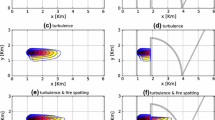Abstract
We construct predictions of fire boundary growth using level set methods. We generate a correction for predictions at the subsequent time step based on current error. The current error is captured by a thin-plate spline deformation from the initial predicted boundary to the observed boundary, which is then applied to the initial prediction at the subsequent time step. We apply these methods to data from the 1996 Bee Fire and 2002 Troy Fire. We also compare our results to earlier predictions for the Bee Fire using the FARSITE method. Error is measured using the Hausdorff distance. We determine conditions under which error correction improves prediction performance.
Access this chapter
Tax calculation will be finalised at checkout
Purchases are for personal use only
Preview
Unable to display preview. Download preview PDF.
Similar content being viewed by others
References
Bookstein, F.: Principal Warps: Thin-plate Splines and the Decomposition of Deformations. IEEE Transactions in Pattern Analysis and Machine Intelligence 14(2), 239–256 (1992)
Chui, H., Rangarajan, A.: A New Algorithm for Non-rigid Point Matching. In: IEEE Conference on Computer Vision and Pattern Recognition (2000)
Finney, M.: FARSITE: Fire Area Simulator-Model, Development and Evaluation. Report RMRS-RP-4, US Department of Agriculture Forest Service, Rocky Mountain Research Station Paper (1998)
Fujioka, F.: A New Method for the Analysis of Fire Spread Modeling Errors. International Journal of Wildland Fire 11, 193–203 (2002)
Mallet, V., Keyes, D., Fendell, F.: Modeling Wildland Fire Propagation with Level Set Methods. Journal of Computers & Mathematics with Applications 57(7), 1089–1101 (2009)
Rothermel, R.: A Mathematical Model for Predicting Fire Spread in 17 Wildland Fuels. Research Paper INT-115, US Department of Agriculture Forest Service (1972)
Rochoux, M., Delmottea, B., Cuenot, B., Riccia, S., Trouvé, A.: Regional-scale simulations of wildland fire spread informed by real-time flame front observations. Proceedings of the Combustion Institute 34(2), 2641–2647 (2013)
Sethian, J.: Level Set Methods and Fast Marching Methods: Evolving Interfaces in Computational Geometry, Fluid Mechanics, Computer Vision, and Materials Science. Cambridge University Press (1999)
Sumengen, B.: A Matlab Toolbox Implementing Level Set Methods, http://barissumengen.com/level_set_methods
Author information
Authors and Affiliations
Editor information
Editors and Affiliations
Rights and permissions
Copyright information
© 2013 Springer-Verlag Berlin Heidelberg
About this paper
Cite this paper
Leonard, K., DeSantis, D. (2013). Error Correction for Fire Growth Modeling. In: Murgante, B., et al. Computational Science and Its Applications – ICCSA 2013. ICCSA 2013. Lecture Notes in Computer Science, vol 7971. Springer, Berlin, Heidelberg. https://doi.org/10.1007/978-3-642-39637-3_18
Download citation
DOI: https://doi.org/10.1007/978-3-642-39637-3_18
Publisher Name: Springer, Berlin, Heidelberg
Print ISBN: 978-3-642-39636-6
Online ISBN: 978-3-642-39637-3
eBook Packages: Computer ScienceComputer Science (R0)




